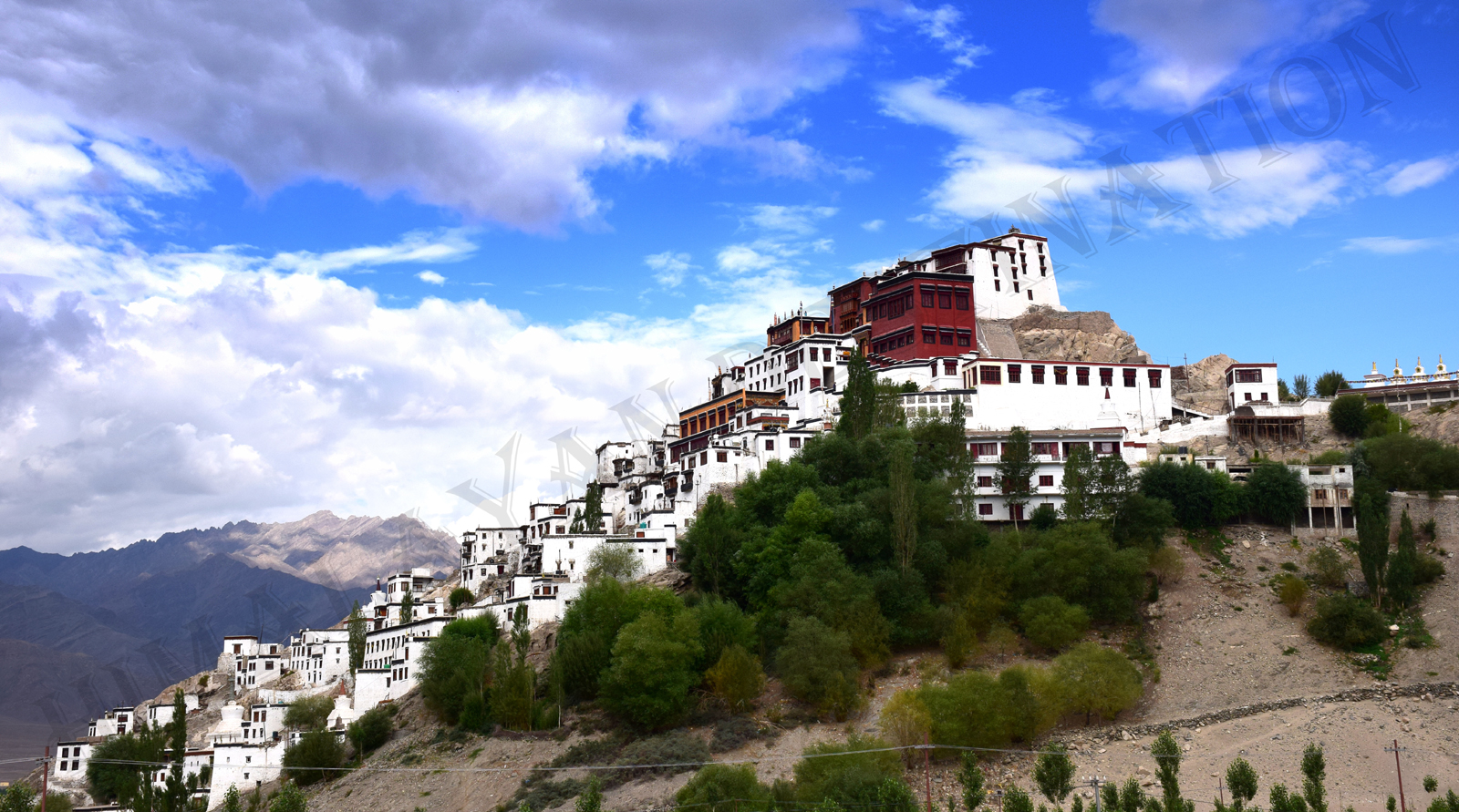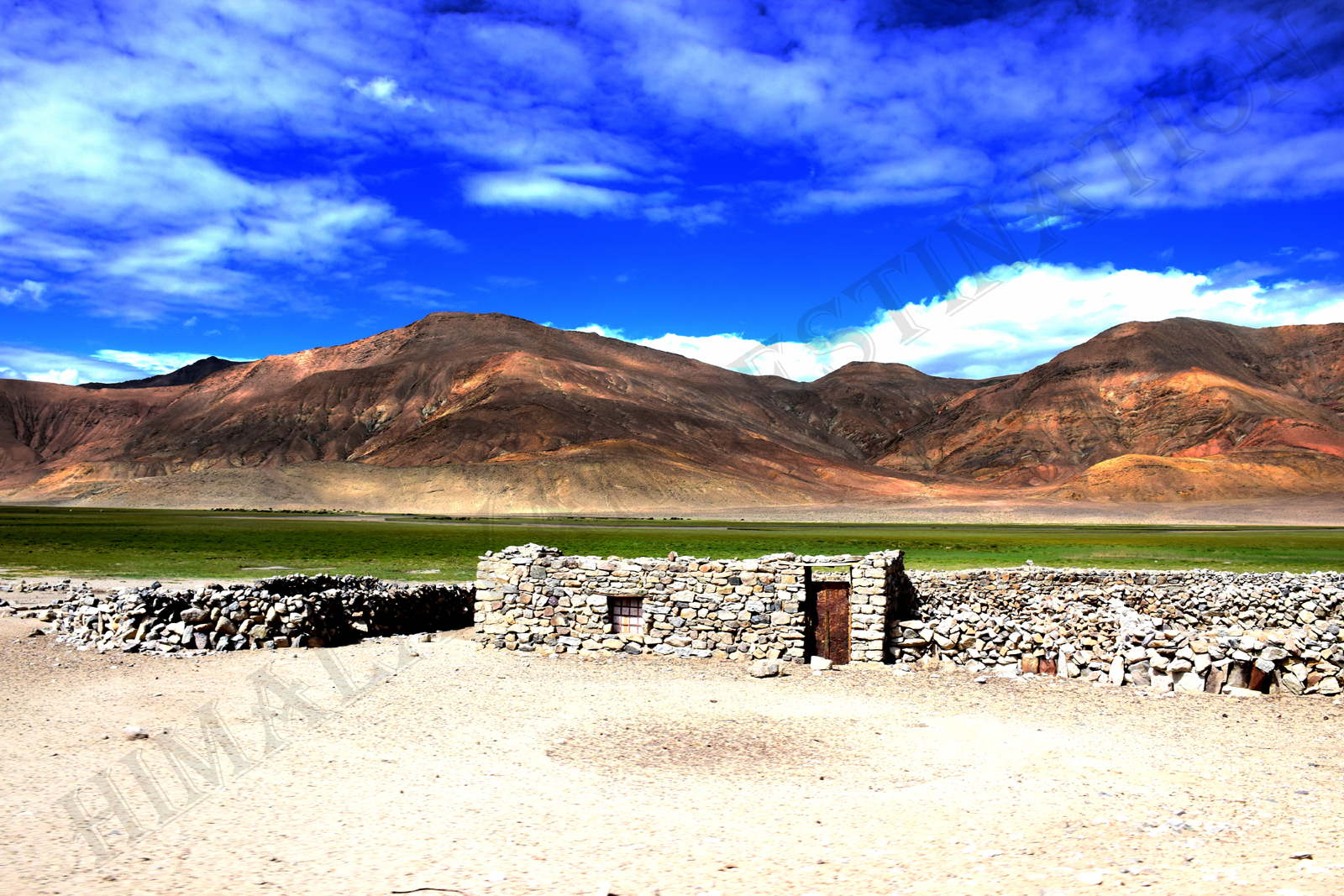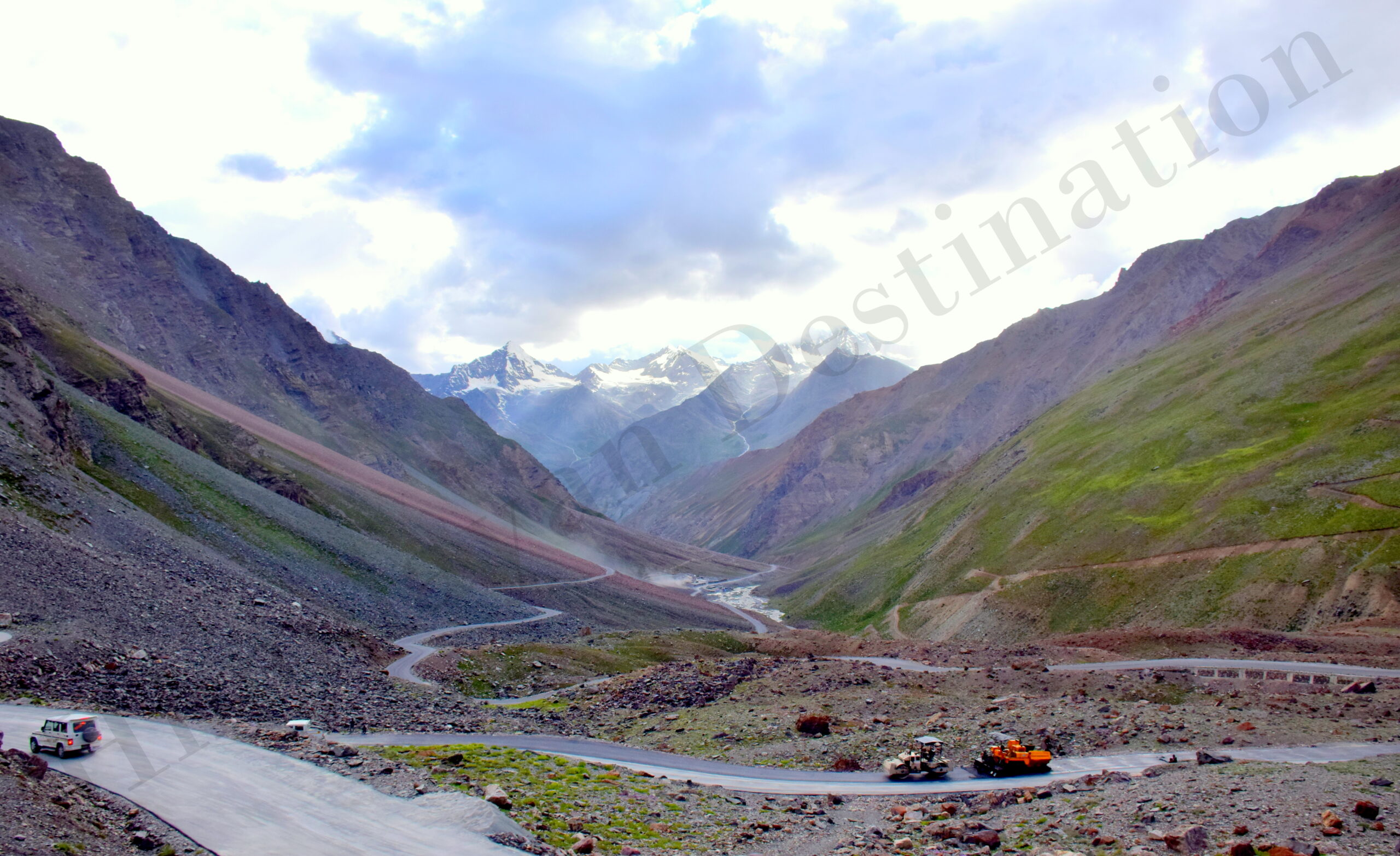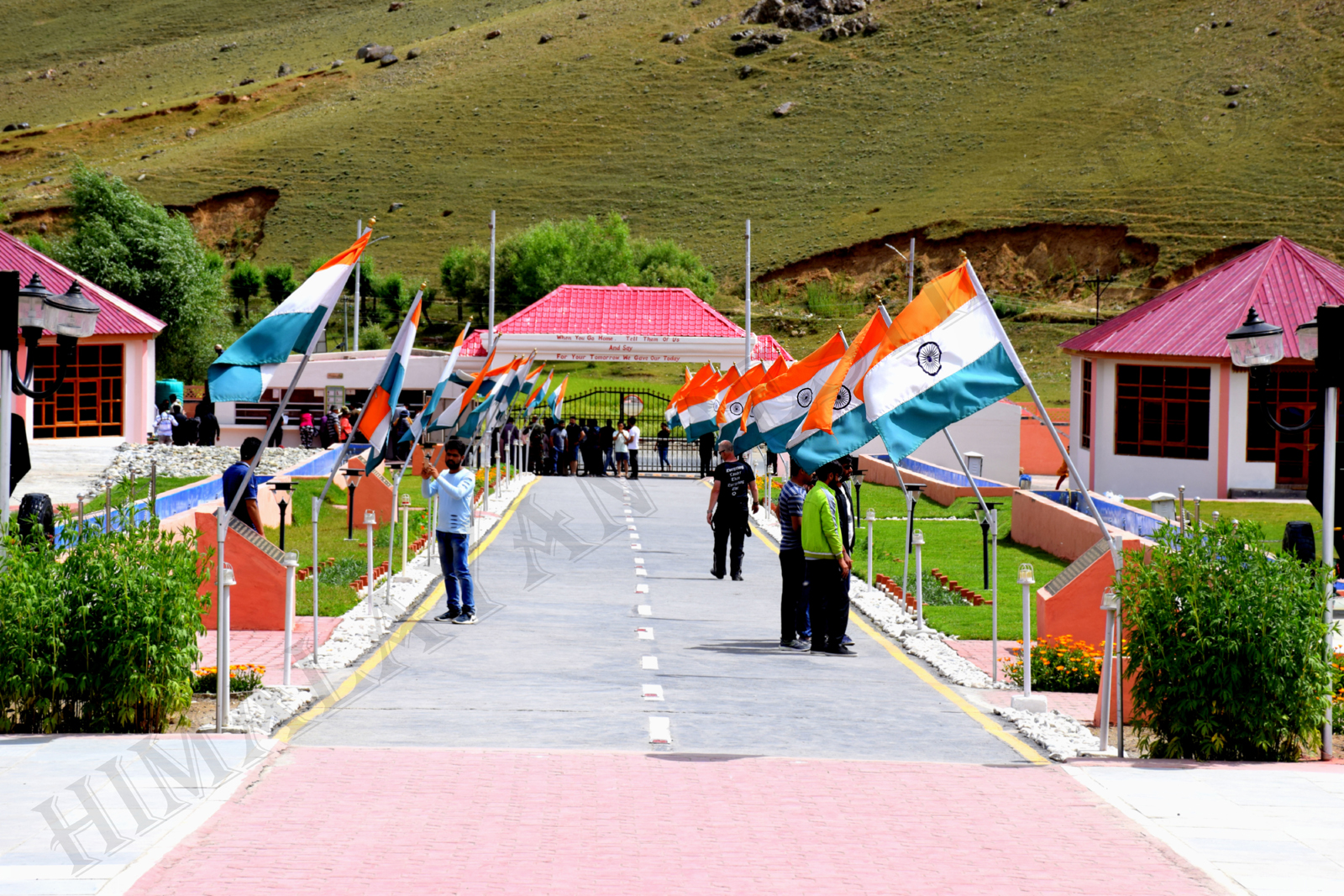
Leh City and Sightseeing around
Leh, at an altitude of 11483 ft. Leh, the dream of reaching Ladakh is finally true, and if you love this place then the excitement to reach Leh will refresh each of your body parts even after these around 12 hours of an arduous journey on the Srinagar Leh / Manali Leh Highway in a single day.
It’s always better to spend a couple of nights at Leh for Leh local sightseeing and get a feel of the culture, people, traditions, Monasteries and magical aura of Leh-Ladakh. It will also help you acclimatize to further sightseeing places in Ladakh.
Main market and Changspa road are two happening places in Leh. So, if you like a lively environment, then try to get a hotel in Leh as close to them as possible. The next day, along with Leh local sightseeing, you can also arrange the Inner Line Permits for other Ladakh destinations you are planning to visit in Leh-Ladakh.
Thiksay Gompa / Thiksay monastery, is a gompa of Tibetan Buddhism religion. It is located on the top of the hill. It is very famous for its similarity with Potala Palace of Lhasa. This monastery is famous for pilgrim activities, architectural elements, sightseeing and exploration. The monastery has an interesting anecdote of how it was built in this exact location. It is said that when two Buddhist monks offered prayers and rituals at the Yellow Temple and were about to through a cake (offering to God) into the valley, a crow took away the cake and place it on a hilltop. They assumed this a divine order and built a monastery here. The morning prayer of Thiksey Monastery is one of the most attractive event and to know about the Buddhist culture.
How to Reach Thiksey Monastery
The Thiksey Monastery is located on top of hill of 3,600 m altitude in Thiksey village. This village is located on the Leh-Manali highway in Jammu and Kashmir. The village lies 18 km to the south of Leh. Leh has a domestic airport, which is the highest airport in the country. The frequency of flights to Leh from other parts of the country is very less. Tourists usually reach India via Delhi or Srinagar airport and choose any land transportation to reach Leh. You can either hire cab to reach Thikse monastery or choose bus. The bus to the monastery starts at 9 in the morning. The bus tour includes many attractions including the monastery and thus, the time limited for exploring the monastery will be less. If you are planning to enjoy the monastery completely, it is better to visit in a car.
Best Time to Visit Thiksey Monastery
The monastery is open to tourists from 7 in the morning to 7 in the evening throughout the week. October and November is the best months to visit the monastery. After November, the place will be closed due to snowfall and it opens by May. After November, the routes to the monastery will be blocked by snow and it becomes dangerous to visit. If you visit during early morning, you can enjoy many unique rituals. Numerous people visit the monastery by 6:00 in the morning to take part in the morning prayers with delicious hot local tea served by the monk. The morning prayer of Thiksey Monastery is one of the most attractive event and to know about the Buddhist culture.
Entry Fee of Thiksey Monastery
The entry cost is 20 INR for both locals and foreigners but it may vary. There is no fee for camera. It would take around 2 hours to scale the whole place.
Places to Visit inside Thiksey Monastery
The monastery holds ten temples, home for monks, assembly hall, nunnery and others. The monastery has 12 levels. It is one of the largest structures in Ladakh. As you enter the monastery, you can find the statue of the protector deity in the entrance. From the monastery, you can enjoy a beautiful view of the flood plains of Indus valley.
- Maitreya Buddha, is one of the important attractions inside the monastery. It is a large statue, which is two storey tall. This is the largest statue in Ladakh.
- The Assembly Hall, is entrance has a wall that has murals of Tibetan calendar. The prayer room next to this wall has many books and manuscripts. Beyond the prayer room, there is a small sanctum. Apart from these, the assembly hall has many pictures, statues and murals.
- Tara Temple, is a small temple dedicated to the Goddess. There are 21 images of the deity in this shrine. You can find many murals here.
- Lamokhang Temple, holds many scriptures including Stangyur and Kangyur. Women are not allowed inside this temple. There is a small school on top of the temple where young boys are taught to become Lamas. You can find a large pillar with Buddha’s teachings engraved on it. Beyond the temple, you can find numerous white huts, the residence of Lamas.
- Nunnery, is one of the most popular school for nuns in the Ladakh region..
Festivals takes place either in November or in October. The festival spans for two days. During this festival, after the morning prayers, the celebrations begin. A sacrificial cake is distributed during this festival. Top attraction of this festival is the mask dance, which is performed by the monks. It is said that the masked dance wade off the evil. The Black Hat dance is performed to re-enact the assignation of Lang Dar Ma by a monk. The exact date of the festival changes every year with respect to the Tibetan calendar. During this festival, a fair takes place at the monastery’s base. This fair is the best place to buy souvenirs and socialize with people.
What to Eat in Thiksey
The monastery offers dinner at 6:30 pm. You can join the monks to enjoy the simple dinner. You have to pick a bowl and stand in a queue to receive Thukpa, a noodle soup with many vegetables. You can also get butter tea here. If you are dining in the monastery, you are requested to clean your dishes.
Hemis Monastery, situated at an altitude of 12000 feet, is the largest Tibetan monastery in the Ladakh region. It is one of the most visited monasteries by tourists on a trip to Leh Ladakh. It sits on a mountain on the west side of the Indus River, only 45 km away from the town of Leh and is one of the prime attractions of the Ladakh trip.
Hemis Monastery belongs to the Drukpa lineage or the red sect of Buddhism and is said to have been first established in the 11th century, and then re-established in the 17th century (approximately year 1670) by the King Sengge Namgyal. So manifestly, it is enriched with a great deal of history and legends.
The history of Hemis Monastery is contained as a transcript of a biography of the pupil of yogi Tilopa – Naropa. This biography was found in the Hemis Monastery and was translated later in various languages. It talks about how Naropa met Tilopa, a tantric master and the tasks that Tilopa assigned to Naropa to achieve enlightenment.
Naropa is considered as the “Abbott of Nalanda,” the famed Monastery / University in the present-day Bihar. This Nalanda University flourished in its full glory until it was sacked by the Afghan-Turkish invaders, which could be the cause of Naropa’s peregrination to the North and ultimately Hemis, where he consequently met Tilopa. It was then that Naropa and Tilopa both traveled back to another university in the kingdom of Magadha in Bihar, called Otantra (no longer in existence now). Naropa went on to become the founding father of the esoteric Buddhist lineage of Kagyu. Thus Hemis became the seat of this Kagyu lineage of Himalayan Buddhism.
Another controversial story proclaims Hemis to be the origin of an unknown gospel of Christianity, according to which, during his ‘lost years,’ Jesus is said to have traveled to India. Today historians find an abundance of incertitude in this particular story as the pieces of evidence are said to be fabricated, rendering the entire account a hoax.
Besides the iconic copper gilded statue of Lord Buddha, the monastery houses a wide collection of historical and religious paintings calledThangkasand various stupas and statues made of gold, silver, and other precious metals.
There is a museum within the monastery where numerous carriers, weapons and other Buddhist relics and artifacts are displayed. The Hemis Monastery is one of the world’s highest settlements at the height of 12000 feet and is the center of Drukpa ancestry where they train Lamas for all the royal monasteries.
About 3 km away from the monastery sits another sacred hermitage, which is said to have been founded by the great Gyalwa Kotsang whose footprint and you can see hand print on a rock inside the cave. The hermitage is adorned by fluttering Buddhist flags and is this visible from far away.
The intricate designs, ancient murals, the three-dimensional mandala and the unique architecture of the monastic complex are a sacred heritage of a rich culture that existed here.
Hemis Festival held every year in the month of June a high-spirited festival dedicated to Lord Padmasambhava (Guru Rinpoche). His birth anniversary falls on the 10th day of the fifth month of the Monk year of the Tibetan calendar. What’s interesting to know here is that this day comes once every 12 years. Thus, it is celebrated as an extravaganza with great festivity and fervor.
People believe that the life mission of Guru Rinpoche was forever to improve the spiritual condition of all living beings, hence, at the festival, sacred rituals are observed to attain spiritual strength and good health.
The Hemis Gompa festival is celebrated in the princely courtyard of the monastery. The beating of drums as an early morning ritual and the clash of cymbals and a spiritual wail of pipes, and it is then when the portrait of Rinpoche is ceremoniously unveiled for all to worship and pay homage.
While you can see musicians performing traditional Ladakhi music in full swing, the main attraction of the festival is the mystic masked dance, called Cham Performance, which is one the most esoteric festivities of the Buddhist tradition. It is a part of a tantric ritual and is performed only at those Gompas that follow the Tantric Vajrayana teachings. You can also see any monks performing tantric worship at the festival.
Hemis Festival Dates 2015, 2016, 2017, 2018, 2019 & 2020
Hemis festival is one of the most important festivals among all the festivals of Ladakh. Usually, the festival is celebrated in the summer months of June and July, depending upon the Tibetan calendar. Here are some of the dates for this festival in the upcoming season of Leh Ladakh tourism.
- Hemis Festival 2015 Date: June 26th & 27th
- Hemis Festival 2016 Date: July 14th & 15th
- Hemis Festival 2017 Date: July 03rd & 04th
- Hemis Festival 2018 Date: June 23rd & 24th
- Hemis Festival 2019 Date: July 11th & 12th
- Hemis Festival 2020 Date: June 30th & July 01st
Best time to visit Hemis
June & July specifically would be the best time to visit the Hemis Monastery when the Hemis Festival is celebrated. Otherwise, May to September is a good time to visit here.
The roads to reach Leh from Manali or Srinagar are closed from October to May respectively, because of heavy snow, therefore traveling via air is the only option to reach Leh and Hemis Monastery during this time.
Hence, the best time to visit Hemis Monastery near Leh (apart from festival time) is the same as the best time to visit Leh Ladakh, that is, from May to September / October when the roads to Leh Ladakh are open from Srinagar and Manali side.
The road to Hemis Monastery from Leh is also open in the winter months. So, you can surely plan a trip to Hemis Monastery from Leh in winter months as well. Please ensure that you are willing to endure the cold weather and want to witness the white beauty of Ladakh.
Druk Padma Karpa School / Rancho’s School / 3-Idiots School, become famous after a blockbuster hit Bollywood movie ‘3-Idiots‘. The school’s sprawling campus is designed like a Buddhist Mandala, and the main gate does not have the word Rancho. Only two big, polished wooden panels on either side of the gate show the name ‘Druk Padma Karpa School’ and the architect firm which built the institution.
After the blockbuster hit movie it become a famous and must visit place in Ladakh region. Sometimes it will very difficult to manage tourist for the school administration.
The 2009 blockbuster was partly shot in the campus of the school which began in 2001. The wall of a building on its campus was featured in the closing of the film in which one of the characters, Chatur, tries to urinate on it but gets an electric shock as two kids dangle a wire with a bulb from the first floor. While the original wall – the ‘iconic idiotic wall’ (Main attraction of the school for tourist), part of a building which was damaged in the 2010 flash floods still remains on the campus, the first floor, earlier made of bricks has been replaced with wooden structures typically used in Ladakh. The wall shows a dangling glowing bulb, a flying Himalayan crane, a rainbow behind the clouds. Students of class 6 and above are generally aware of this famed wall.
Keeping in mind, the influx of tourists from all parts of India and few parts of the world, a duplicate wall has been created on the other side of the school in another area, with an iron mesh door separating the two sides, carrying a sign – ‘Private gate, no public thorough fare’, so that no tourist can wander in the academic campus. School administrator have created a visitor’s centre and Rancho’s Cafe, Photo Zone to allow tourist to enjoy without disturbing the school which has over 800 students.
Few teachers and students, while aware of the overwhelming fame and spotlight the film has lent to the school, also want people to refer to the school as Druk Padma Karpo School and not as ‘Rancho’s School.
Shey Palace, is about 15 Km from Leh and lies on the Leh-Manali road. The Palace locates on the top of a hillock overlooking the Shey village and a sandy trail connects the palace with the highway. There are numerous prayer wheels along the trail which suggest the existence of a monastery inside the erstwhile royal palace. Deldan Namgyal, the 6th King of Ladakh, in the memory of his father built the Shey Palace and the Shrine in 1655. It was used as a summer palace by the royal families. The protruding balconies of Shey Palace are magnificent to give you a feel like a King while standing there and posing for a camera shot. In the extreme right side of the palace there are white chortens which add beauty to the splendid view of Shey. The Palace has the largest Namgyal Chorten (victory stupa) in Ladakh, the top of which is made of pure gold. A post of sentry still stands tall around the ruined fortress. The king who built the Shey Palace also built a monastery adjacent to it, which is known as “Shey Monastery”.
Spituk Monastery / Spituk Goompa, is, yet another interesting monastery, on the hill top near Indus about 18 kms. from Leh on Srinagar road. The Spituk monastery offers a commanding view of Indus. It has a totally new Gompa within the monastery as well as the old Gompa has also been restored meanwhile. It is constructed in a series of tiers with courtyards and steps. Higher up in the hill is a chamber which houses the enormous statue of goddess. Its face is covered and uncovered only once in a year during the festival time.
The Spituk Gompa was founded in 11th century by Od-De, the elder brother of Lha Lama Changchub-od. The Gompa was named Spituk (exemplary) by Rinchen Zangpo, a translator came to that place and said that exemplary religious community would rise. Initially the Gompa was run according to the Kadampa school then during the reign of king Gragspa Bumide he converted it to Gayluk Pa order. Many icons of Buddha and 5 thangkas can be visited in this 15th century monastery. The Dukhang Hall is the largest building and has two rows of seats running the length of the walls to a throne at the far end. Sculptures and miniature chortens are displayed on the altar. There is also a collection of ancient masks, antique arms and fine thangkas. Higher up the hill is the Mahakal Temple, containing the shrine of Vajrabhairava. The terrifying face of Vajrabhairva is unveiled only at the annual festival in January.
Every year, on the 17th and 19th day of the 11th of the Bodhi month, the Gelukpa order of monks celebrate the Spituk festival known as Gustor. During the festival, the lamas wear the masks of religious deities and perform the dances, which is normally about good and evil and mythological stories related to the Buddhism.
Leh Palace, is a former royal palace overlooking the town of Leh, in the lap of Himalayan Range. The palace was constructed approximately 1600 by Sengge Namgyal. The palace was abandoned when Dogra forces took control of Ladakh in the mid-19th century and forced the royal family to move to Stok Palace.
It is nine storeys high; the upper floors accommodated the royal family, while the lower floors held stables and store rooms. Much of the palace is in deteriorated condition and little survives of its interior decorations. The Palace Museum holds a rich collection of jewellery, ornaments, ceremonial dresses and crowns. Chinese Thangka or Paintings, which are more than 450 years old, with intricate designs still retain the bright colors derived from crushed and powdered gems and stones. Structures around the palace’s base include the prominent Namgyal Stupa, the colorfully muralled Chandazik Gompa and the 1430 Chamba Lhakhang, with medieval mural fragments located between the inner and outer walls. The palace is now being restored and maintained by the Archaeological Survey of India.
The palace is open to the public and the roof provides panoramic views of Leh and the surrounding areas.
Shanti Stupa, was built in 1991 by Japanese Buddhist Bhikshu, Gyomyo Nakamura as a part of the Peace Pagoda mission. The stupa is a symbol of the ties between the people of Japan and Ladakh. Within the stupa, there are relics of the Buddha, enshrined by the 14th Dalai Lama. The stupa is spread over two levels. First level has Buddha idol, and second features relics depicting the “birth” of Buddha, the death of Buddha (mahanirvana) and Buddha “defeating the devils” while meditating.
Getting There
Located at an altitude of 3,609 metres (11,841 ft), Shanti Stupa can be reached by car or by climbing a series of 500 steep steps to the hilltop. Closest landmark to the Shantii Stupa is Leh Palace.
Timings:
05:00 AM to 09:00 PM, Open all days
Things to Do and See in and around
One can also visit the Leh Palace, which is quite close to the Shanti Stupa. Don’t forget to click some amazing pictures against the backdrop of the stupa. From here, the view of Leh is extremely beautiful. Tourists can also consider visiting the market nearby the Shanti Stupa to pick some local handicrafts.
Best time to visit
June to September will be the best times to plan a trip to the Shanti Stupa as the roads are clear. The day remains warm and sunny with a sudden dip in temperatures towards the evening.
Things to remember for travel to Leh-Ladakh
BSNL Postpaid Connection does work like a charm in Leh town with some loss of signal at few places though.
Many petrol pumps are available in Leh Town. But please keep in mind fill the fuel tank of your vehicle before leave the town.
Many ATM are available in Leh Town. You can found the ATM from most of the major banks. But please keep in mind withdraw sufficient cash or fill your pocket before leave the town.
Leh has the only major hospital in entire Ladakh. Though the hospital is well equipped, they might not be able to handle a major medical emergency. They can support you only non emergency situation. If you have a medical condition, it is best advised that you consult your doctor before going to Ladakh. There are few small clinics and dispensaries as well in Leh.
Preferred Vehicles for Leh local sightseeing
The higher ground clearance vehicles are preferable and 4×4 ones generally not required. However, the road conditions in this region is mostly very good, and may use hatchback or a sedan. But, it depends upon your skills to drive.
Best Time to travel or explore Leh
You can explore Leh city through-out the year, but you have to decide which season is suitable for you or which beauty you are looking for.
- January to March, Leh town have less tourist at this time and few roads may not accessible due to thick layer of snow. Only a few options are available to stay and open to welcome guests. Suggest for extremely adventurous tourist for this time who want to know how Himalaya look in this season. It is very difficult to survive in the chilled weather. Stay at centrally heated guest house / hotel at this time for your safety. Main problem in this season is chilled weather.
- April, Leh, some guest houses / hotels start to open. You can see apricot flowers blooming around Leh town in few areas in April. This time is also considered for those who like chilled weather and heavy snow. Few roads may not accessible in time also. Stay at centrally heated guest house / hotel at this time for your safety. Main problem in this season is chilled weather.
- May, June, July and August, Leh, which is the peak tourist season in Ladakh. You can find all accommodation options open with full staff and support even in remote areas also during these months of the year.
- September and October, Leh, the tourists start to reside as the cold starts to set in and accommodation starts to pack up too. In our opinion, this is by far the best time to visit Leh to see the full glory of the burning colors of Ladakh with clouds hovering like candies in the blue sky.
- November to December, Leh going to partial shut down again. Temperature drop frequently. Few areas inaccessible due to snow falls started. Limited options are available to stay. Suggest for adventurous tourist for this time who want to survive and enjoy the chilled weather. Stay at centrally heated guest house / hotel at this time for your safety. Main problem in this season is chilled weather.



